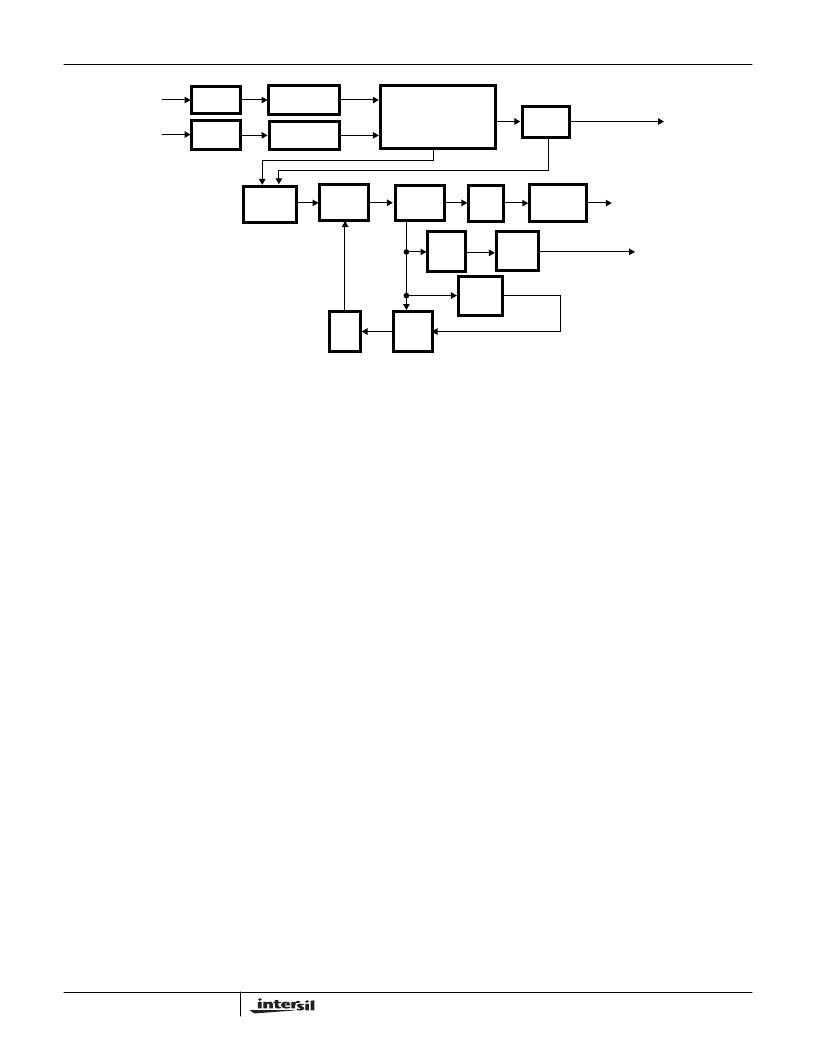- 您現(xiàn)在的位置:買賣IC網(wǎng) > PDF目錄371807 > HFA3824A (Intersil Corporation) Direct Sequence Spread Spectrum Baseband Processor PDF資料下載
參數(shù)資料
| 型號: | HFA3824A |
| 廠商: | Intersil Corporation |
| 元件分類: | 基帶處理器 |
| 英文描述: | Direct Sequence Spread Spectrum Baseband Processor |
| 中文描述: | 直接序列擴頻基帶處理器 |
| 文件頁數(shù): | 19/40頁 |
| 文件大?。?/td> | 271K |
| 代理商: | HFA3824A |
第1頁第2頁第3頁第4頁第5頁第6頁第7頁第8頁第9頁第10頁第11頁第12頁第13頁第14頁第15頁第16頁第17頁第18頁當(dāng)前第19頁第20頁第21頁第22頁第23頁第24頁第25頁第26頁第27頁第28頁第29頁第30頁第31頁第32頁第33頁第34頁第35頁第36頁第37頁第38頁第39頁第40頁

2-117
Acquisition Description
The PRISM baseband processor uses either a dual antenna
mode of operation for compensation against multipath inter-
ference losses or a single antenna mode of operation with
faster acquisition times.
Two Antenna Acquisition
During the 2 antenna (diversity) mode the two antennas are
scanned in order to find the one with the best representation
of the signal. This scanning is stopped once a suitable signal
is found and the best antenna is selected.
A projected worst case time line for the acquisition of a signal in
the two antenna case is shown in Figure 14. The synchroniza-
tion part of the preamble is 128 symbols long followed by a 16-bit
SFD. The receiver must scan the two antennas to determine if a
signal is present on either one and, if so, which has the better
signal. The timeline is broken into 16 symbol blocks (dwells) for
the scanning process. This length of time is necessary to allow
enough integration of the signal to make a good acquisition deci-
sion. This worst case time line example assumes that the signal
is present on antenna A1 only (A2 is blocked). It further assumes
that the signal arrives part way into the first A1 dwell such as to
just barely miss detection. The signal and the scanning process
are asynchronous and the signal could start anywhere. In this
timeline, it is assumed that all 16 symbols are present, but they
were missed due to power amplifier ramp up. Since A2 has
insufficient signal, the first A2 dwell after the start of the pream-
ble also fails detection. The second A1 dwell after signal start is
successful and a symbol timing measurement is achieved.
Meanwhile signal quality and signal frequency measure-
ments are made simultaneous with symbol timing measure-
ments. When the bit sync level, SQ1, and Phase variance
SQ2 are above their user programmable thresholds, the sig-
nal is declared present for the antenna with the best signal.
More details on the Signal Quality estimates and their
programmability are given in the Acquisition Signal Quality
Parameters section of this document.
At the end of each dwell, a decision is made based on the rel-
ative values of the signal qualities of the signals on the two
antennas. In the example, antenna A1 is the one selected, so
the recorded symbol timing and carrier frequency for A1 are
used thereafter for the symbol timing and the PLL of the NCO
to begin carrier de-rotation and demodulation.
Prior to initial acquisition the NCO was inactive and DPSK
demodulation processing was used. Carrier phase measure-
ment are done on a symbol by symbol basis afterward and
coherent DPSK demodulation is in effect. After a brief setup
time as illustrated on the timeline of Figure 14, the signal
begins to emerge from the demodulator.
If the descrambler is used it takes 7 more symbols to seed
the descrambler before valid data is available. This occurs in
time for the SFD to be received. At this time the demodulator
is tracking and in the coherent PSK demodulation mode it
will no longer scan antennas.
One Antenna Acquisition
When only one antenna is being used, the user can delete the
antenna switch and shorten the acquisition sequence. Figure
15 shows the single antenna acquisition timeline. It uses a 78
symbol sequence with 2 more for power ramping of the RF
front of the radio. This scheme deletes the second antenna
dwells but performs the same otherwise. It verifies the signal
after initial detection for lower false alarm probability.
Acquisition Signal Quality Parameters
Two measures of signal quality are used to determine acqui-
sition and drop lock decisions. The first method of determin-
ing signal presence is to measure the correlator output (or
bit sync) amplitude. This measure, however, flattens out in
the range of high BER and is sensitive to signal amplitude.
The second measure is phase noise and in most BER sce-
narios it is a better indication of good signals plus it is insen-
sitive to signal amplitude. The bit sync amplitude and phase
noise are integrated over each block of 16 symbols used in
acquisition or over blocks of 128 symbols in the data demod-
SIGNAL QUALITY 1
CORRELATOR
16TAP
MAGNITUDE AND
PHASE DISTRIBUTION
A/D
SECTION
A/D
SECTION
CORRELATOR
16TAP
DATA
DESCRAM
DIF
DEC
PSK
DEMOD
PHASE
ROTATE
TIMING
CONTROL
AVG
PHASE
FREQ.
AVG
PHASE
ERROR
ABS
PHASE
ERROR
SIGNAL QUALITY 2
SYMBOL TIMING
I
Q
SYMBOL
TIMING
NCO
LEAD
/LAG
FILTER
RXD
FIGURE 13.
DEMODULATOR BLOCK DIAGRAM
HFA3824A
相關(guān)PDF資料 |
PDF描述 |
|---|---|
| HFA3842B | PCMCIA/USB Wireless LAN Medium Access Controller |
| HFA3842BIN | PCMCIA/USB Wireless LAN Medium Access Controller |
| HFA3842BIN-TK | PCMCIA/USB Wireless LAN Medium Access Controller |
| HFA3842IN96 | Wireless LAN Medium Access Controller |
| HFA3842 | Wireless LAN Medium Access Controller |
相關(guān)代理商/技術(shù)參數(shù) |
參數(shù)描述 |
|---|---|
| HFA3824AIV | 制造商:Rochester Electronics LLC 功能描述:BASEBAND PROCESSOR - Bulk |
| HFA3824AIV WAF | 制造商:Harris Corporation 功能描述: |
| HFA3824AIV96 | 制造商:Rochester Electronics LLC 功能描述:BASEBAND PROCESSOR - Bulk |
| HFA3824EVAL | 制造商:Rochester Electronics LLC 功能描述:- Bulk |
| HFA3824IV | 制造商:Rochester Electronics LLC 功能描述:- Bulk |
發(fā)布緊急采購,3分鐘左右您將得到回復(fù)。